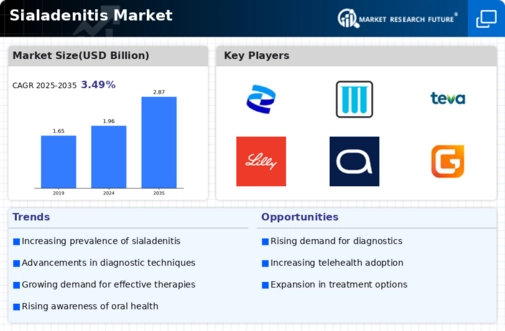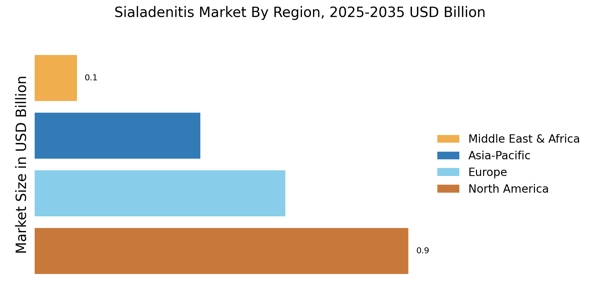Growing Geriatric Population
The aging population is a significant driver of the Sialadenitis Market. As individuals age, they often experience a decline in salivary gland function, making them more susceptible to sialadenitis. According to demographic data, the proportion of individuals aged 65 and older is projected to increase substantially in the coming years, leading to a higher incidence of age-related health issues, including sialadenitis. This demographic shift necessitates targeted healthcare strategies and treatment options tailored to the elderly, thereby expanding the market. The Sialadenitis Market must adapt to meet the unique needs of this population, potentially leading to the development of specialized therapies and support services.
Emerging Treatment Modalities
The emergence of novel treatment modalities is a pivotal driver in the Sialadenitis Market. Recent advancements in pharmacotherapy, including the development of new anti-inflammatory agents and antibiotics, are enhancing treatment options for sialadenitis. Additionally, minimally invasive surgical techniques are gaining traction, offering patients effective alternatives to traditional surgery. The introduction of biologics and regenerative medicine approaches may also revolutionize the management of sialadenitis, providing more effective and targeted therapies. As these innovative treatments become available, they are likely to attract attention from healthcare providers and patients alike, thereby stimulating growth in the Sialadenitis Market. The potential for improved patient outcomes through these emerging therapies underscores the dynamic nature of this market.
Rising Incidence of Sialadenitis
The increasing prevalence of sialadenitis is a notable driver in the Sialadenitis Market. Factors such as dehydration, poor oral hygiene, and certain medications contribute to the rising incidence of this condition. Recent studies indicate that sialadenitis affects approximately 1 in 1,000 individuals annually, with higher rates observed in older populations. This growing patient demographic necessitates enhanced treatment options and healthcare services, thereby propelling market growth. As healthcare providers become more aware of the condition, the demand for effective therapies and interventions is likely to rise, further stimulating the Sialadenitis Market. The need for innovative solutions to manage and treat sialadenitis effectively is becoming increasingly apparent, suggesting a robust market potential in the coming years.
Advancements in Diagnostic Techniques
Innovations in diagnostic methodologies are significantly influencing the Sialadenitis Market. Enhanced imaging techniques, such as ultrasound and MRI, allow for more accurate and timely diagnosis of sialadenitis. These advancements facilitate early intervention, which is crucial for effective treatment outcomes. The introduction of point-of-care testing and other rapid diagnostic tools is also expected to streamline the diagnostic process, thereby increasing patient throughput in clinical settings. As healthcare systems adopt these advanced technologies, the demand for diagnostic services in the Sialadenitis Market is likely to expand. This trend not only improves patient care but also encourages further investment in research and development, potentially leading to new therapeutic options.
Increased Focus on Preventive Healthcare
The growing emphasis on preventive healthcare is shaping the Sialadenitis Market. As awareness of oral health and its impact on overall well-being rises, individuals are more inclined to seek preventive measures against conditions like sialadenitis. Educational campaigns and public health initiatives are promoting better oral hygiene practices, which may reduce the incidence of sialadenitis. This shift towards prevention is likely to drive demand for products and services aimed at maintaining salivary gland health. Consequently, the Sialadenitis Market may witness an increase in the development of preventive care solutions, including oral rinses and dietary supplements designed to support salivary function.


















Leave a Comment